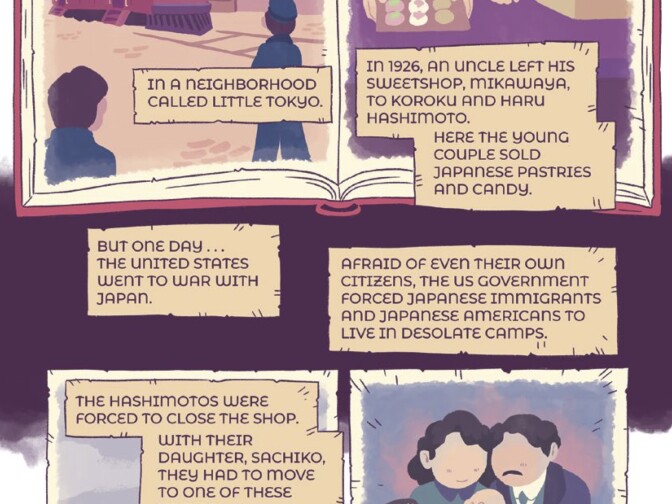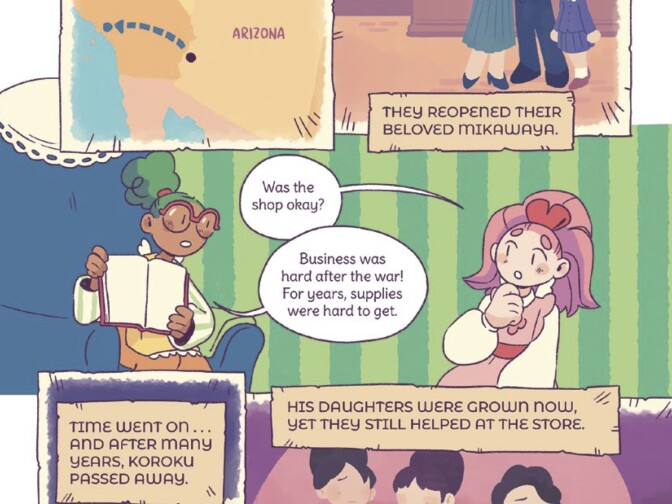Truth matters. Community matters. Your support makes both possible. LAist is one of the few places where news remains independent and free from political and corporate influence. Stand up for truth and for LAist. Make your year-end tax-deductible gift now.
This Droolworthy Graphic Novel Explores The History Of Dessert

Cake. Donuts. ICE CREAM. If you want to explore the sweet life with a guided tour of treats from around the world, pick up Yummy: A History of Desserts. Cartoonist Victoria Grace Elliott's new graphic novel takes readers on a global tour with recipes, history and adorable illustrations.
Elliott, who made her name in the world of webcomics, has illustrated three children's books but Yummy is her first graphic novel. She combined her cartooning skills, a love of food history and a background in media studies to bring these tales to life. Although the target audience is 8- to 12-year-olds, the material is mouthwatering enough to intrigue most adults.

A World Of Treats
Most of the book's eight chapters open with an atlas noting where a particular dessert — ancient Persian yakhchal, Austrian chocolate torte, New Orleans beignets, South African melktert — originated. After creating a webcomic that featured mostly European foods, Elliott realized her perception might be skewed.
"We think of all these as European or Western desserts but vanilla's not Western, sugar's not Western, chocolate's not Western. They may be from the Western Hemisphere but chocolate and vanilla are indigenous to the Americas. How did that end up in Europe?" Elliott says.
Our perception of what constitutes a "delicacy" or "haute cuisine" is shaped by our baseline cultural assumptions. Often, those are racist and classist or, at least, extremely Eurocentric. Americans often think certain foods originated in Europe (potatoes, tomatoes and chocolate are good examples) but Elliott points out that in Ye Olde Times, only rich people had access to certain items — among them, ice cream. Criminal, right?
Hosted by a collection of mystical sprites who happen to be about the same size as the food they're exploring, Yummy was inspired by kawaii characters such Hello Kitty and Sumikko Gurashi. Elliott was particularly influenced by Japanese manga series Cardcaptor Sakura.
"There's one character, he's a little lion plushie, and he loves desserts. I was like, 'Oh, it would be so cute if I had these little mascot characters who were talking about the food, obsessed with the food and also about the same size as the food,'" Elliott says.
She worked in pastels and chose colors she thought would make the work look cute and feel inviting.
Her goal? To make readers look at food in a new way and think about where it comes from — and to help us understand that these origin stories aren't accidents.

How Los Angeles Gave Us Mochi Ice Cream
Yummy tells one fascinating food story that originated here, in Los Angeles — how mochi ice cream became a beloved dessert.
The tales starts in the 1920s, in a Little Tokyo sweetshop named Mikawaya. Members of the Hashimoto family inherited the store from an uncle and sold Japanese pastries and candy until World War II, when they were interned in concentration camps.
"I feel like even characters this cute and simple can acknowledge something that's difficult to talk about. It was also kind of a purposeful political thing on my part. Because I grew up in the South, I feel like there's a lot of history I didn't learn until I was in college. Sometimes, the things we take for granted ended up here through an ugly sequence of events," Elliott says.
She wanted to include the cruel realities of Japanese American internment in Yummy since she figured her target audience may not learn much about this dark episode in history class.
"I'm hoping that if they're curious about it, they can ask their parents or their teachers," Elliott says.
Along with ugly histories we don't always acknowledge, Elliott's book shares fascinating tidbits about the South's influence on American cuisine. Take, for example, beignets. These fried balls of dough came from France but it wasn't until African chefs put their spin on them that the New Orleans-style beignet we know today became a thing. The sugary dessert is still popular today.
Back in Los Angeles, the Hashimoto family reopened their sweet shop after WWII and the next generation took charge. But the business was struggling. One of the daughters, Frances Hashimoto, in addition to opening more stores, worked to preserve and improve Little Tokyo.
Decades later, Hashimoto's husband suggested combining traditional mochi rice cakes with ice cream. It took years to perfect but they found the right recipe and in 1994 started selling mochi ice cream balls in both their Mikawaya shops and around the world.
"You're sort of like, 'Oh, yeah, somebody had to think to put these two things together,'" Elliott says.

Between Fact And Fiction
Some foods can definitively be traced to specific geographical and cultural sources. Others have origin stories that are equal parts truth and urban legend. For foods whose origins can't be verified, Elliott switches from the book's cute cartoons to a simpler, painted style with the facial features removed from the characters who are being discussed. She wanted to create distance between the readers and the characters, the graphic novel equivalent of using puppets.
"There are so many fun stories we tell ourselves and each other that are sort of word-of-mouth stories about history. In the ice cream chapter, there's the legend of the waffle cone, which has a lot more exaggeration to it," Elliott says.
That common myth about waffle cones involves an ice cream vendor at the 1904 St. Louis World's Fair selling a delectable new treat. After he used up all his cuts, a nearby vendor who sold waffle bread rushed over and said they should combine their treats. But a number of people claim to have invented the waffle cone, as Elliott notes, and its real inventor may not have been at the fair. Still, it was the place where many people tried waffle cones for the first time.
Yummy highlights other legends of occasionally dubious veracity such as the claim that mooncakes began nearly a thousand years ago in China when it was under Mongol rule, or how red velvet cake was born in Austin, Texas thanks to a food coloring salesman.
Elliott dug into the history behind another treat with California origins — Japanese-style strawberry shortcake — but it didn't make the cut for the book.
Unlike the American version, Japanese-style strawberry shortcake is made with a light, fluffy sponge cake as the base, rather than the denser cake that's most common in the United States, according to Drive Me Hungry. The dessert originated in the early 20th century when Japanese baker Fujii Rin'emon visited the U.S., according to Rafu Shimpo. During his time in Los Angeles and San Francisco, he was inspired by the American sweet and when he returned to Japan, he made his own version of strawberry shortcake.
"He studied under these patisseries and that's how he got the chiffon cake down pat," Elliott says. The dessert remains popular in Japan, particularly at Christmas, and a growing number of Japanese and Korean bakeries here in the U.S. now make their own versions of it.
"I did actually find an interesting story about how it became popular in Japan but there were so many other cakes to talk about, there wasn't space for it [in the book]," Elliott says.
The book also includes recipes, combined from different sources and tested by Elliott. They're designed to be simple enough that kids can help make them.
"The snickerdoodle one was the one that required the most tweaking. I kept making it and then it'd be way too dry or way too soft. I'm mostly a cookie person in terms of baking, so that one I felt comfortable experimenting with. I can never do a cake right if it's not a cake mix," Elliott says.
You can read the full mochi ice cream story below, along with a sneak peek at one of its recipes but for the scoop on the ice cream instructions, you'll have to check out the book.
The Book's Secret Section And The Next Level Of Yumminess
One thing you won't find in Yummy? A section on chocolate. The history of this foodstuff is so long and complicated Elliott didn't think she could tackle it in one go. Instead, she wove chocolate's history into various sections, including ones about ice cream and cake.
She also had to cut some sweetness. Hard candies and gelatin didn't make the cut but the book has a section on gummies. She traces their origins back to Turkey in the 1700s. The most popular one from that era was Turkish delight, developed in 1777 and popularized by candymaker Haci Bekir Efendi. The techniques used in Turkey spread throughout Europe and North America, with new methods coming into use along the way.
"Gummies had a pretty interesting history. It's also one of those things where you're like, how did somebody think to do this?" Elliott says.
Fortunately, Elliott is already working on a sequel. Yummy: A History of Tasty Experiments is set for a 2023 release. Get ready to learn about cheese, soda, pizza and a host of other sweet and savory items, from gelatin to gooey butter cake (a Midwestern classic).
"My favorite chapter is on what I've called 'easy food,' but it's essentially all of the weird food, packaged food, frozen food and canned food that came out in the industrialization era. Stuff like SPAM is in it," Elliott says.
After that, Elliott is looking forward to hanging up her researcher's hat and writing stories that are fully fictional, cute sprites notwithstanding.
"I've loved doing the research but I realize I am not an academic for a reason. I love focusing on food, so hopefully I can still have food components to what I do," Elliott says.
Once your mind has been expanded by these fun food factoids, you might also find your waistline expanding. Although Elliott isn't planning on leading you away from temptation, you have time to recover before her next food-focused graphic novel. Or maybe you can experiment with some of the recipes in this book and launch your own culinary legend.
Yummy: A History of Desserts is available for preorder and will be released Tuesday, Nov. 30.














